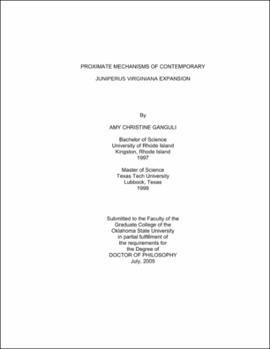| dc.contributor.advisor | Engle, David | |
| dc.contributor.author | Ganguli, Amy Christine | |
| dc.date.accessioned | 2013-12-10T18:04:34Z | |
| dc.date.available | 2013-12-10T18:04:34Z | |
| dc.date.issued | 2005-07 | |
| dc.identifier.uri | https://hdl.handle.net/11244/7729 | |
| dc.description.abstract | Scope and Method of Study: The purpose of this study was to determine the influence of plant community traits and resource availability on Juniperus virginiana expansion and to examine conservation programs that promote the use of J. virginiana for conservation purposes. Survival and growth of transplanted J. virginiana seedlings were evaluated in three plant communities within an oak forest-tallgrass prairie ecotone. Understory canopy cover by species was measured on 1-m2 quadrats surrounding each seedling. Soil chemical and physical properties (NO3-N, NH4-N, and soil texture) were measured around each seedling, and photosynthetic active radiation was measured above each seedling. We surveyed state nurseries to evaluate the extent of J. virginiana seedling distribution programs throughout the United States, identified major uses for the seedlings, and determined the duration of the distribution programs. Detrended correspondence analysis, chi-square analysis, logistic regression, regression, and path analysis were used to analyze data. | |
| dc.description.abstract | Findings and Conclusions: Greater levels of plant species diversity provide little safeguard to plant communities threatened by J. virginiana expansion. However, J. virginiana expansion may be limited in areas where plant species composition reflects the presence of abiotic stressors such as limited resource environments. J. virginiana seedling survival and seedling growth were inconsistently related to a single resource factor as a direct influence across plant communities and spatial scales. However, indirect and direct influence of a single belowground resource factor, soil clay content, emerged as an integrating resource factor that drives J. virginiana seedling survival and seedling growth. All of the plant communities we investigated are susceptible to J. virginiana expansion, differing only in the probable rates of conversion to J. virginiana woodland. J. virginiana is extensively used as a conservation species for windbreaks and wildlife habitat in the United States especially in the prairies of the Great Plains. Planting and subsequent expansion of eastern redcedar threatens remaining prairie fragments and other vegetation types in many areas of North America. | |
| dc.format | application/pdf | |
| dc.language | en_US | |
| dc.rights | Copyright is held by the author who has granted the Oklahoma State University Library the non-exclusive right to share this material in its institutional repository. Contact Digital Library Services at lib-dls@okstate.edu or 405-744-9161 for the permission policy on the use, reproduction or distribution of this material. | |
| dc.title | Proximate mechanisms of contemporary Juniperus virginiana expansion | |
| dc.contributor.committeeMember | Fuhlendorf, Samuel | |
| dc.contributor.committeeMember | Hellgren, Eric | |
| dc.contributor.committeeMember | Palmer, Michael | |
| osu.filename | Ganguli_okstate_0664D_1434.pdf | |
| osu.accesstype | Open Access | |
| dc.type.genre | Dissertation | |
| dc.type.material | Text | |
| thesis.degree.discipline | Plant and Soil Sciences | |
| thesis.degree.grantor | Oklahoma State University | |
